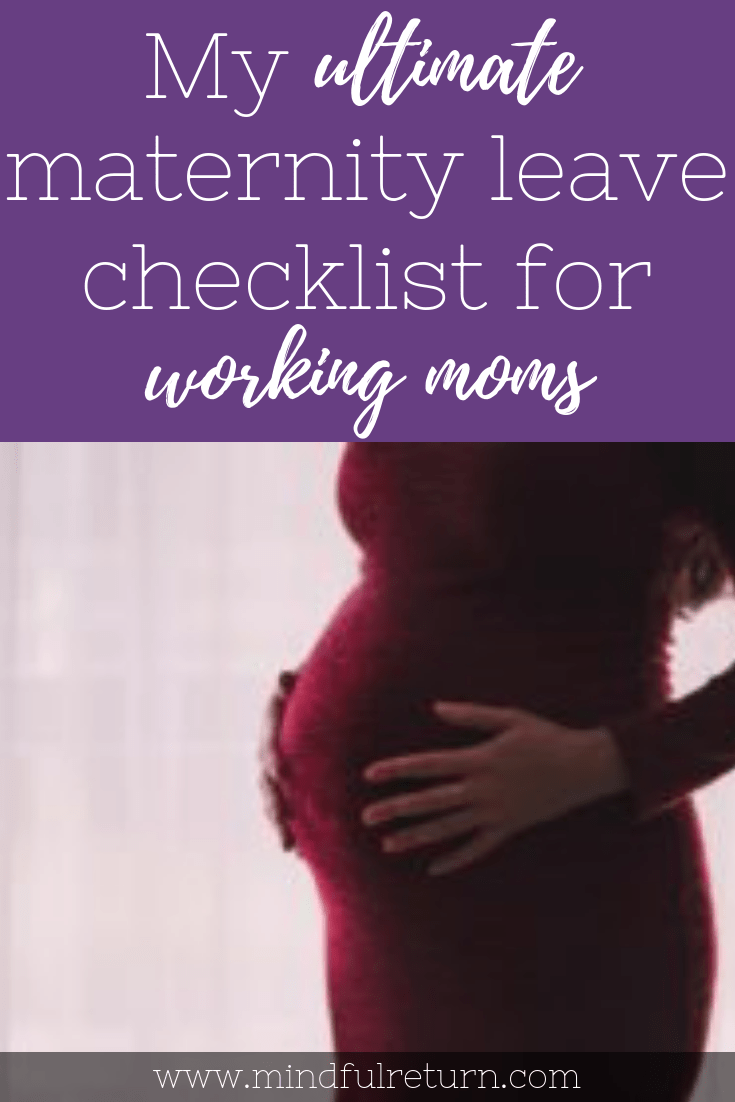 Congratulations! You are expecting a little one, and that maternity leave that was once looming off in the distance, is getting closer and closer. I know, you want to be prepared. But there seem to be a million things to do to get ready, and you’re having trouble keeping them all straight.
Congratulations! You are expecting a little one, and that maternity leave that was once looming off in the distance, is getting closer and closer. I know, you want to be prepared. But there seem to be a million things to do to get ready, and you’re having trouble keeping them all straight.
Inspired by some fabulous mama leaders – Dana Bash, Jewelyn Cosgrove, Nedra Pickler, and Stephanie Weeks – who have done the maternity leave thing recently, my own experience, and that of the women I’ve coached, I’ve pulled together four categories of maternity leave to-dos to think about as you plan your leave. Check these things off your list before baby arrives, and you’ll be more than prepared. I promise.
1. Prep for Your Departure from Work
- Check in with HR: Your human resources department should be one of your first stops at the office as you start to announce your pregnancy. Find out from them what their leave policies are and what Family Medical Leave Act (FMLA) forms you’ll need to fill out. Don’t forget to ask about benefits, too. Will any retirement match you receive continue when you’re on FMLA? How do you add your baby to your insurance? If your HR manager can’t answer your questions, be calm but persistent. Not all HR departments are well-oiled machines when it comes to parental leave. Don’t stop until you get all your questions answered.
- Develop your maternity leave transition plan: You’ll need to start thinking about what your job entails, who will take over your responsibilities, how much time you’ll take off, and how you’ll transition back. Think about putting your whole plan in one document like Jewelyn Cosgrove, Associate Director of Federal Government Affairs for a national trade association, who got big props from her employer for the formal maternity leave plan she created. Here are some key to-dos to get your plan ready:
- Document your processes and projects.
- Discuss coverage options with your supervisor.
- Plan for supervision and mentoring of your direct reports.
- Carve out dedicated time to teach those who will be covering for you about what they’ll need to do and to introduce them to your key contacts.
- Create an If-I-Go-Into-Labor-In the Office document with information about where you plan to deliver, phone number of your ob/gyn, doula, midwife, etc., and emergency contact numbers, and share it with a few trusted colleagues.
- Negotiate the duration of your leave. Stephanie Weeks, Vice President at Blackboard, advises new mothers to “plan to take as much time as you possibly can off of work. As much as you love your job,” she says, “all will be well without you, and you will feel more confident going back with more time at home.”
- Explore phased-in reentry and flexible work options for your return. Ask for flexible options on a trial basis to help your employer feel comfortable.
- Develop a communication plan with your office for while you are on leave that outlines whether and when you plan to check in. Weeks recommends designating “someone at work you trust to keep you ‘in the loop’ with what’s going on at work, so you can totally disconnect electronically but still feel like you have a line to anything big that may change while you’re out.”
- Want a template for putting this plan together for your employer? Get the Mindful Return Maternity Leave Template here.
- Block breast pumping time on your calendar now: If you have an Outlook calendar and some control over your schedule, consider blocking out six months or a year’s worth of pumping time now. (I blocked three ½-hour periods per day.) If you wind up not needing the time, it’s easy to delete the calendar appointments. But it’s hard to get that time back if others schedule you to be elsewhere.
- Build your leave and return into your work goals: As you can tell just from this checklist, a well-planned and executed leave and reentry is no small feat. Take credit for all the hard work you’re doing to leave and return in a thoughtful and professional manner, by talking to your manager about how you might build maternity leave planning into your goals and your evaluation process.
2. Get Ready for Baby
- Prep your gear: You already know babies seem to require warehouses full of gear. I remember laughing that in the first week of his life, my baby had more seating options in our one-bedroom condo than I did. Ask friends who already have children to help you put together a registry to weed out the useful from the useless. And check out Baby Bargains, which is a bit like the Consumer Reports of baby stuff. Don’t stress too much if the crib of your dreams won’t arrive in time, or you can’t put the finishing touches on a nursery, though. Neither of my little guys slept in a crib in until a few months after their arrival on the scene. (And the Fisher Price Rock N Play saved our lives…)
- Explore childcare options: Nedra Pickler, Managing Director at the Glover Park Group and former AP journalist covering the White House explains that “depending on where you live, you’ll want to start researching child care options early.” Talk to moms who have a variety of arrangements (think nanny, nanny share, au pair, daycare center, in-home daycare, family) to get their perspectives. And if you’re going the daycare center route, be prepared for a scramble.
- “Here in Washington, you need to get on a daycare waitlist during pregnancy if you can,” advises Pickler, mom to two boys. “I thought that sounded nuts when I was pregnant, but it’s true.” While you’re pregnant, space out your visits to daycare centers (my husband and I toured one a month) to avoid overwhelm. And then when you’re on maternity leave, “you need to work those waitlists like a job and network,” says Pickler. “Those things are not really run in order and can be kind of a racket — the order of admission is totally up to the staff. I would go on tours to meet as many members of the staff as I could and check in regularly with the director. I made sure they knew I would be an involved parent and would bring them a deposit check the moment they had an opening.” Be sure to follow up interactions with thank you notes too, Pickler advises. “One day care center called to offer my baby a spot immediately, admitting they leaped our family to the head of the line, because they appreciated the handwritten thank you note.”
- Line up a pediatrician: It’s helpful to select a pediatrician before your baby arrives, both because they will plan to come visit your baby right after birth, and because some pediatricians only accept newborns into their practices. Get recommendations from friends and colleagues, and go meet with them to get a feel for their office and style. (Yes, you’ll probably get charged for this visit, but it’s worth it.)
- Explore pumping equipment and lactation consultants: It’s good to know where you can go for pumping gear and help with breastfeeding—because sometimes when you need help feeding your baby, you wind up scrambling to find someone! Pre-empt that worry by locating lactation consultants (LCs) recommended by friends or pediatricians. If you will be nursing, explore different pumps and features (wireless, backpack models, etc.) to figure out what you’ll need for your lifestyle.
- Prepare for delivery: Make sure your significant other knows the route to your hospital or birthing center, take some birth and baby classes, and pack the trunk of your car. Explore whether hiring a doula (and/or post-partum doula) might make sense for you. And of course if you have other children, don’t forget to come up with some options for who can watch them when the big day arrives.
- Keep an open mind: Above all, Stephanie Weeks recommends “being open to doing things differently” than you might otherwise have imagined. “From birthing methods to feeding choices to child care, there are so many options. You truly cannot know what’s best for you and your family until it’s time.”
3. Take Care of YOU, Mama
- Do not (I repeat NOT) make to-do lists for during your leave: CNN Correspondent Dana Bash learned this lesson the hard way. “Given my Type A personality,” she said,” I made a long to-do list for my time off. Make scrap books, organize the garage – all the things I never have time to do.” But did she have time for any of this? You guessed it: “Once the baby came, I realized that was all a pipe dream. As a semi-competent older mom, I thought handling a baby would be manageable,” Bash said. But she admits she was wrong. “I was all consumed and totally at a loss by how to handle my little 6-pound miracle.” Bash was lucky, though, that a friend came to the rescue to bring her maternity leave expectations “down to earth.” Her friend explained to her that she should “set a goal for one basic task per day (I mean basic, like doing laundry or showering), and if you can do that, it’s a successful day.” All that said, don’t be afraid to line up a few things you’d like to watch on Netflix, some books you’d like to read (here are some of my recommendations for working moms), or some apps you’d like to explore for that inevitable baby-feeding downtime.
- Brainstorm ways to make your life easier post-baby: Think about ways that you can delegate and automate processes. Buy a slow cooker. (Or, my favorite kitchen appliance, the 4-in-1 slow cooker, rice cooker, oatmeal maker, veggie steamer.) Explore food delivery options. Research baby nurses and post-partum doulas in your area. See if there’s a local teenager you can recruit to be a parents’ helper a few hours a week. Extra sets of hands can be lifesavers.
- Relish the final weeks: Pickler recommends that expectant mamas “take as much time to pamper themselves as they can in the final weeks,” given that life is about to be completely consumed with caring for another human being. “I made sure to schedule plenty of time to sleep,” she said, “and used my lunch hour to go for a short swim at the local indoor pool. It was glorious to feel weightless for 20 minutes.” And if you’re able to take any time off for yourself pre-baby, Pickler encourages you to go for it. She used that time “to exchange baby gifts that we got in duplicate and to get more of that precious sleep with a daily nap.”
- Make micro self-care a daily habit: When baby arrives, of course, time for yourself takes on an entirely new (and relatively nonexistent) meaning. Now, while you are pregnant, is the time to make small acts of self-care a daily habit, so you can maintain some sanity after the baby arrives. Explore what fills you up. Journal about it. And find things that can calm you down and recharge you in 5 minutes or less. For me, that’s stretching and setting an intention for my day while I’m in the shower.
4. Connect to Community
- Make some new mama friends: One of the most important things women who are about to go on leave can do, says Pickler is to “make friends who have babies born close to the same time.” How to do this? Pickler advises women to research “playgroups, hospital new mother support groups, baby yoga classes, or even the nursing room at Nordstrom. You need someone to talk to who is going through the same experiences,” she advises. A lot of these experiences can seem strange, “and you wonder if you are crazy,” she says, “but if you have friends with babies close in age, they likely will be going through the same things.” She also notes that “if their baby is a couple months older or younger, they may be in a different phase and not even clearly remember that new thing you are experiencing.” Weeks couldn’t agree more. “Take a class or join a support group!” she said emphatically. And be sure to think about both in-person and online communities. (I teach the ‘Mindful Return’ e-course to help women prepare for the transition back to work.)
- Connect with other parents at work: Are there already supportive communities for parents at your office? If so, connect. If not, consider starting one. I founded a “Returning to Work Community” at my office after my second child and we connected through monthly brown-bag lunches and a Google+ group. (Here’s more on how to create a working parent posse at your office.) Also consider putting lunch on the books for your first day back at the office with a colleague who is also a parent and can relate to the transition.
- Get family and friends on the same page: The world will likely be dying to meet your little cherub, and watching your family and friends bond with baby can be magical. Have serious discussions with your partner, though, about when and how often you’d like visitors. (My husband and I had a week-long no-fly zone after our first baby, which we loved, but were quicker to accept visitors and help after our second.) Once you agree on a visiting plan, communicate it to your circle.
Final Words of Wisdom
Want the honest truth? Whether you get through this checklist or not before baby arrives, you’re going to be just fine, mama. Our little ones have a way of surprising us with their arrival dates, so know that whatever you’ve done is enough. My last piece of advice is this: once your baby arrives, throw all to-do lists – including this one – out the window and just love love love that little baby.
Looking for more practical help with your return to work after maternity leave? Take the next session of the Mindful Return E-Course.


